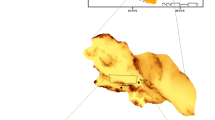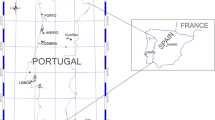Abstract
Changes in magnetic and chemical properties of soil during the growth of tomato plants (Lycopersicon esculentum) are examined in this study. The synthetic soils, prepared from sand, topsoil and organic material, were treated with magnetite powder (<5 μm) in order to simulate metal contamination. Six soil treatments were prepared from two soil types: controls, low-contamination and high-contamination treatments (0.01 and 0.05 g of magnetite powder/kg soil, respectively). Overall, the contaminated soils had a greater decrease in magnetic susceptibility (MS) than the controls, and the difference in MS decrease between the treatments was found to be statistically significant for both soil types. Potential reasons for the overall MS decrease were explored, and among them, trace element uptake by plants probably had a minor contribution as the concentration differences of Fe and other trace elements (Ni, Mn) between treatments were not statistically significant. In soils, oxidized and weakly magnetic minerals (maghemite, goethite and hematite) were common after plant growth, when compared with the untreated (background) soil. Such mineral transformations could have contributed to the overall MS decrease. The results show that exposure to Fe contaminants can affect plant growth and suggest that plant growth can measurably change the magnetic properties of their growth media. While the potential variables affecting plant growth were controlled as much as possible, there still remains the potential that biotic and abiotic chemical reactions could have affected the results. Thus, continuous monitoring of the changes in soil magnetic and chemical properties in more complex soil–plant systems is needed.









Similar content being viewed by others
Notes
Seedling plants established, about 4 weeks of growth; vegetative until first flower opens, about 8 weeks of growth; reproductive until first fruiting occurs, about 10 weeks of growth; harvestable plant terminated after fully grown, about 12 weeks of growth.
References
Angers DA, Caron J (1998) Plant induced changes in soil structure: processes and feedbacks. Biogeochemistry 42:55–72
Bell JNB, Treshow M (2002) Air pollution and plant life, 2nd edn. Wiley, London
Brake SS, Jensen RR, Mattox JM (2004) Effects of coal fly ash amended soils on trace element uptake in plants. Env Geol 45(5):680–689
Brown JC (1978) Mechanism of iron uptake by plants. Plant Cell Environ 1(4):249–257
Brown JC, Von Jolley D (1989) Plant metabolic responses to iron-deficiency stress. BioSciences 39(8):546–551
Charlesworth SM, Lees JA (2001) The application of some mineral magnetic measurements and heavy metal analysis for characterising fine sediments in an urban catchment, Coventry, UK. J Appl Geophys 48:113–125
Connolly EL, Guerinot ML (2002) Iron stress in plants. Genome Biol 3(8):1–4
Curran PJ, Dunan JL, Gholz HL (1990) Exploring the relationship between reflectance red edge and chlorophyll content in slash pine. Tree Physiol 7:33–48
Day R, Fuller M, Schmidt VA (1977) Hysteresis properties of titanomagnetites: grain-size and compositional dependence. Phys Earth Planet Interior 13:260–267
Dong H, Fredrickson JK, Kennedy DW, Zachara JM, Kukkadapu RK, Onstott TC (2000) Mineral transformation associated with the microbial reduction of magnetite. Chem Geol 169:299–318
Ebbs SD, Kochian LV (1998) Phytoextraction of Zinc by Oat (Avena sativa), Barley (Hordeum vulgare), and Indian Mustard (Brassica juncea). Environ Sci Technol 32:802–806
Emerson D (2000) Microbial oxidation of Fe(II) and Mn(II) at circumneutral pH. In: Lovely DR (ed) Environmental Microbe-Metal Interactions. ASM Press, Washington, pp 31–52
Gautam P, Blaha U, Appel E (2005) Magnetic susceptibility of dust-loaded leaves as a proxy of traffic-related heavy metal pollution in Kathmandu city, Nepal. Atmos Environ 39:2201–2211
Goddu SR, Appel E, Jordanova D, Wehland F (2004) Magnetic properties of road dust from Visakhapatnam (India)––relationship to industrial pollution and road traffic. Phys Chem Earth 29:985–995
Grimley DA, Arruda NK, Bramstedt MW (2004) Using magnetic susceptibility to facilitate more rapid, reproducible and precise delineation of hydric soils in the midwestern USA. Catena 58:183–213
Hanesch M, Scholger R (2002) Mapping of heavy metal loadings in soils by means of magnetic susceptibility measurements. Env Geol 42:857–870
Hansen LD, Silberman D, Fisher GL (1981) Crystalline components of stack-collected, size-fractionated coal fly ash. Environ Sci Technol 15(9):1057–1062
Hell R, Stephan UW (2003) Iron uptake, trafficking and homeostasis in plants. Planta 216:541–551
Housen BA, Musgrave RJ (1996) Rock magnetic signature of gas hydrates in accretionary prism sediments. Earth Planet Sci Lett 139:509–519
Jensen RR, Brake SS, Mattox JM (2004) Trace element uptake in plants grown on fly ash amended soils. Toxicological and Environmental Chemistry 86(4):219–230
Kabata-Pendias A, Pendias H (1984) Trace elements in soils and plants. CRC Press, Inc, USA
Kapicka A, Jordanova N, Petrovsky E, Ustjak S (2001) Effect of different soil conditions on magnetic parameters of power-plant fly ashes. J Appl Geophys 48:93–102
Kappler A, Straub KL (2005) Geomicrobiological cycling of iron. Rev Mineral Geochem 59:85–108
Kovacs K, Kuzmann E, Fodor F, Vertes A, Kamnev AA (2005) Mossbauer study of iron uptake in cucumber root. Hyperfine Interact 165:289–294
Krolak E (2003) Accumulation of Zn, Cu, Pb and Cd by Dandelion (Taraxacum officinale Web.) in environments with various degrees of metallic contamination. Polish J Environ Stud 12(6):713–721
Lecoanet H, Leveque F, Segura S (1999) Magnetic susceptibility in environmental applications: comparison of field probes. Phys Earth Planet Interiors 115:191–204
Maher BA (1998) Magnetic properties of modern soils and Quaternary loessic paleosols: paleoclimatic implications. Palaeogeogr Palaeoclimatol Palaeoecol 137:25–54
Marsh HV, Evans HJ, Matrone G (1963) Investigations of the role of iron in chlorophyll metabolism II. Effect of iron deficiency on chlorophyll synthesis. Plant Physiol 38:638–642
Matzka J, Maher BA (1999) Magnetic biomonitoring of roadside tree leaves, identification of spatial and temporal variations in vehicle-derived particulates. Atmos Environ 33:4565–4569
Monna F, Puertas A, Leveque F, Losno R, Fronteau G, Marin B et al (2008) Geochemical records of limestone facades exposed to urban atmospheric contamination as monitoring tools? Atmos Environ 42:999–1011
Moreno E, Sagnotti L, Turell JD, Winkler A, Cascella A (2003) Biomonitoring of traffic air pollution in Rome using magnetic properties of tree leaves. Atmos Environ 37:2967–2977
Muxworthy AR, Schmidbauer E, Petersen N (2002) Magnetic properties and Mossbauer spectra of urban atmospheric particulate matter: a case study from Munich, Germany. Geophys J Int 150:558–570
Norusis MJ (2000) SPSS® 10.0 guide to data analysis. Prentice-Hall, Inc, New Jersey
Novel PS (1977) Water relations of flowering of Agave Deserti. Botanical Gazette 138(1):1–6
Petrovsky E, Kapicka A, Zapletal K, Sebestova E, Spanila T, Dekkers MJ et al (1998) Correlation between magnetic parameters and chemical composition of lake sediments from northern Bohemia-Preliminary study. Phys Chem Earth 23(9–10):1123–1126
Porsch K, Dippon U, Rijal ML, Appel E, Kappler A (2010) In Situ magnetic susceptibility measurements as a tool to follow geomicrobiological transformation of Fe minerals. Environ Sci Technol 44:3846–3852
Roden EE, Zachara JM (1996) Microbial reduction of crystalline iron (III) oxides: influence of oxide surface area and potential for cell growth. Environ Sci Technol 30:1618–1628
Sapkota B, Cioppa MT (2009) Effects of atmospheric pollutants on plant growth and on soil magnetic properties: preliminary results from controlled experiments. Eos Trans AGU 90(22), paper no. GP32A-04
Schmidt A, Yarnold R, Hill M, Ashmore M (2005) Magnetic susceptibility as proxy for heavy metal pollution: a site study. J Chem Explor 85:109–117
Schwertmann U, Murad E (1983) Effect of pH on the formation of goethite and hematite from ferrihydrite. Clays Clay Miner 31(4):277–284
Sharma AP, Tripathi BD (2008) Magnetic mapping of fly-ash pollution and heavy metals from soil samples around a point source in a dry tropical environment. Environ Monit Assess 138:31–39
Snowden RED, Wheeler BD (1993) Iron toxicity to Fen plant species. J Ecol 81(1):35–46
Spassov S, Egli R, Heller F, Nourgaliev DK, Hannam J (2004) Magnetic quantification of urban pollution sources in atmospheric particulate matter. Geophys J Int 159:555–564
Strzyszcz Z, Magiera T (1998) Magnetic susceptibility and heavy metals contamination in soils of southern Poland. Phys Chem Earth 23(9–10):1127–1131
Stumm W, Lee GF (1961) Oxygenation of ferrous iron. Ind Eng Chem 53(2):143–146
Theis TL, Wirth JL (1977) Sorptive behavior of trace metals on fly ash in aqueous systems. Environ Sci Technol 11(12):1096–1100
Thompson R, Oldfield F (1986) Environmental magnetism. Allen and Unwin Publications Ltd, UK
Woodard TL, Thomas RJ, Xing B (2003) Potential for phytoextraction of cobalt by tomato. Commun Soil Sci Plant Anal 34(5 and 6):645–654
Acknowledgments
The authors acknowledge a Premier’s Research Excellence Award and a Natural Sciences and Engineering Research Council award to Dr. Maria T. Cioppa. They would like to thank Daniel Hanley for assisting the color measurements, Ambika Paudel for assisting in morphological measurements, and Dr. Michael Jackson at the Institute for Rock Magnetism (University of Minnesota) for hysteresis measurements. They are grateful to Dr. Ihsan Al-Aasm and an anonymous reviewer for providing helpful comments that improved this paper.
Author information
Authors and Affiliations
Corresponding author
Rights and permissions
About this article
Cite this article
Sapkota, B., Cioppa, M.T. & Gagnon, J.E. Investigation of the changes in magnetic and chemical properties of soil during plant growth in a controlled environment. Environ Earth Sci 65, 385–399 (2012). https://doi.org/10.1007/s12665-011-1099-4
Received:
Accepted:
Published:
Issue Date:
DOI: https://doi.org/10.1007/s12665-011-1099-4




